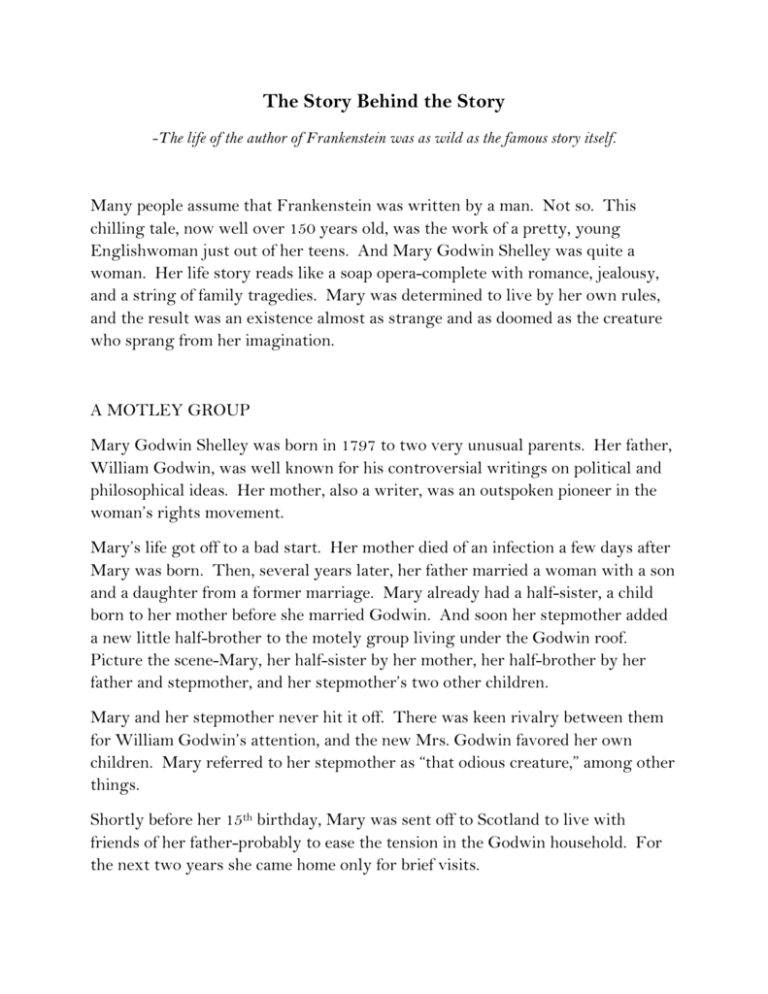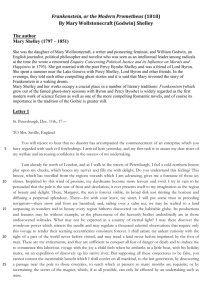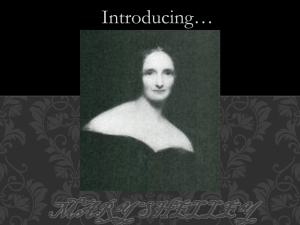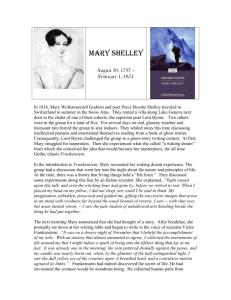Frankenstein + Mary Shelley + The Story Behind the Story
advertisement

The Story Behind the Story -The life of the author of Frankenstein was as wild as the famous story itself. Many people assume that Frankenstein was written by a man. Not so. This chilling tale, now well over 150 years old, was the work of a pretty, young Englishwoman just out of her teens. And Mary Godwin Shelley was quite a woman. Her life story reads like a soap opera-complete with romance, jealousy, and a string of family tragedies. Mary was determined to live by her own rules, and the result was an existence almost as strange and as doomed as the creature who sprang from her imagination. A MOTLEY GROUP Mary Godwin Shelley was born in 1797 to two very unusual parents. Her father, William Godwin, was well known for his controversial writings on political and philosophical ideas. Her mother, also a writer, was an outspoken pioneer in the woman’s rights movement. Mary’s life got off to a bad start. Her mother died of an infection a few days after Mary was born. Then, several years later, her father married a woman with a son and a daughter from a former marriage. Mary already had a half-sister, a child born to her mother before she married Godwin. And soon her stepmother added a new little half-brother to the motely group living under the Godwin roof. Picture the scene-Mary, her half-sister by her mother, her half-brother by her father and stepmother, and her stepmother’s two other children. Mary and her stepmother never hit it off. There was keen rivalry between them for William Godwin’s attention, and the new Mrs. Godwin favored her own children. Mary referred to her stepmother as “that odious creature,” among other things. Shortly before her 15th birthday, Mary was sent off to Scotland to live with friends of her father-probably to ease the tension in the Godwin household. For the next two years she came home only for brief visits. During one of these visits, Mary met Percy Bysshe Shelley, a brilliant and handsome young poet who was impressed with her father’s writings and had become a frequent visitor at the Godwin home. When Mary returned from Scotland for good, she and Percy fell in love. The young poet already had a wife and two children, and divorce was then considered scandalous. But public disapproval didn’t stop Mary and Percy. Marriage was not important to them-being together was all that really mattered. FURIOUS FATHERS In the summer of 1814, when Mary was 17, the two lovers shocked family and friends by running off to Paris. Mary’s father, who had considered Percy a close friend, felt betrayed by the poet. Percy’s father was outraged. This was really the last straw. His son had already been expelled from college for handing out pamphlets that questioned the existence of God. Now this! Mary’s stepmother might have secretly welcomed Mary’s sudden departure-but she discovered that her own daughter, Claire, had gone with them! Both fathers cut off financial support. For the next two years, Mary, Percy, and Claire lived pretty much hand-to-mouth. Percy sold a few poems and managed to borrow against his inheritance. But the three were constantly moving to avoid being thrown into prison for their debts. THE CREATURE COMES In the summer of 1815, Mary, Percy, and Claire rented a house on Lake Geneva in Switzerland. When the weather turned foul and rain kept them indoors for days at a time, Mary and Percy amused themselves by reading a collection of German ghost stories. In the evening, they had long discussions with an eccentric local doctor named Polidori and with another young, dashing, handsome, and unconventional English poet named George Gordon Byron. Lord Byron-his family were nobility-had rented a house close to his friends. One evening, as darkness slowly settled on Lake Geneva, Lord Byron suggested a contest. Everyone would write a “tale of horror.” When each work was finished, the author would read it aloud. Then a winner would be chosen. Mary liked the idea, but she couldn’t seem to come up with an exciting plot. She wanted her story to be one that would, as she put it, “make the reader dread to look round, would curdle the blood and quicken the beatings of the heart.” Nothing came to her. Then late one night, Mary listened as Percy, Polidori, and Lord Byron discussed a strange experiment. They had heard that a well-known scientist had kept a piece of vermicelli (1) under glass until, by some extraordinary means, it began to move on its own. Talk of this experiment led to an intriguing idea: What might happen if someone put some sort of creature together from parts of corpses and brought that creature to life? The idea fascinated Mary. Later that night, as she lay in bed drifting toward sleep, a dreamlike image came to her of a pale student kneeling beside the body of a creature he had put together. The creature, which was attached in some way to a powerful engine, suddenly began to show signs of life, and “stir with an uneasy half-vital motion.” INFLUENCED BY PROMETHEUS LEGEND The next morning, Mary began writing her story. As it took shape, she found herself influenced by the legend of Prometheus in Greek mythology. Percy Shelley had always been fascinated by Prometheus and had written a long poem about the legend. Now Mary thought of the story: Despite warnings, Prometheus brings life-giving fire to humans. For challenging the gods, he is chained to a rock. Each day he suffers agony as an eagle tears out his liver, and each night the liver grows back so that he might suffer once more. In Mary’s tale, a young doctor dreams of assuming godlike powers and creating life. He assembles various body parts, all meant to create a human of great strength and beauty. But when the reality comes to life, the dream has gone hideously wrong. Dr. Frankenstein has created not a beautiful young man but a creature that will be rejected by the world. The fates of the doctor and the creature are the heart of her story. Mary won the contest-with no competition, since none of the others had finished their tales. Later she expanded the story into a novel. The book, published in 1818 as Frankenstein, became an instant best-seller. At age 21, Mary had reached the high point of her life. From then on everything seemed to turn wrong. Broken-hearted because her husband had left her, Percy Shelley’s wife drowned herself. Percy and Mary married and tried to get custody of his children. The court ruled him an unfit parent. Then Mary’s half-sister committed suicide. Between 1815-1820 Mary gave birth to four children. But by the time she was 22, three of the four had died. The final tragedy came in the summer of 1822. While Percy and two friends were sailing off the coast of Italy, a sudden storm came up. The boat overturned, and all on board were drowned. (2) RECOGNITION AT LONG LAST Despite these terrible blows, Mary held herself together. She continued to write, producing four novels, five biographies, and many short stories. But fame escaped her. She was a woman author in a day when writing was thought to be something that only men could do. When Mary died in 1851, her first book was world famous, but she was almost unknown. But now, more than a century later, she has come into her own. The fame of her creation remains as bright as ever, and her incredible life has stirred interest among scholars and the general public. What started as a scary story that dark night in Geneva is now one of the best-known classics of world literature. (1) A form of pasta that looks like spaghetti but is smaller in circumference. The literal meaning in Italian is “small worms.” (2) Lord Byron died two years later while helping the Greeks in their fight for freedom from Turkish rule.








